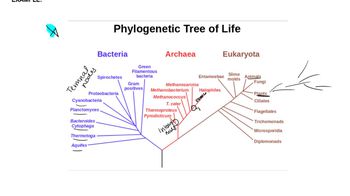Table of contents
- 1. Introduction to Genetics51m
- 2. Mendel's Laws of Inheritance3h 37m
- 3. Extensions to Mendelian Inheritance2h 41m
- 4. Genetic Mapping and Linkage2h 28m
- 5. Genetics of Bacteria and Viruses1h 21m
- 6. Chromosomal Variation1h 48m
- 7. DNA and Chromosome Structure56m
- 8. DNA Replication1h 10m
- 9. Mitosis and Meiosis1h 34m
- 10. Transcription1h 0m
- 11. Translation58m
- 12. Gene Regulation in Prokaryotes1h 19m
- 13. Gene Regulation in Eukaryotes44m
- 14. Genetic Control of Development44m
- 15. Genomes and Genomics1h 50m
- 16. Transposable Elements47m
- 17. Mutation, Repair, and Recombination1h 6m
- 18. Molecular Genetic Tools19m
- 19. Cancer Genetics29m
- 20. Quantitative Genetics1h 26m
- 21. Population Genetics50m
- 22. Evolutionary Genetics29m
22. Evolutionary Genetics
Phylogenetic Trees
Problem 21
Textbook Question
Using the following amino acid sequences obtained from different species of apes, construct a phylogenetic tree of the apes. <>
 Verified step by step guidance
Verified step by step guidance1
span>Step 1: Align the amino acid sequences from the different species of apes to identify similarities and differences. This can be done using sequence alignment tools like ClustalW or MUSCLE.</span
span>Step 2: Calculate the genetic distance between each pair of sequences. This involves counting the number of differences between the sequences and can be expressed as a percentage or a numerical value.</span
span>Step 3: Use the genetic distances to construct a distance matrix. This matrix will help in visualizing the evolutionary distances between the species.</span
span>Step 4: Apply a phylogenetic tree construction method, such as the Neighbor-Joining method or Maximum Likelihood method, to the distance matrix to infer the evolutionary relationships.</span
span>Step 5: Draw the phylogenetic tree based on the inferred relationships, ensuring that the branches reflect the genetic distances and evolutionary paths of the species.</span
 Verified video answer for a similar problem:
Verified video answer for a similar problem:This video solution was recommended by our tutors as helpful for the problem above
Video duration:
4mPlay a video:
Was this helpful?
Key Concepts
Here are the essential concepts you must grasp in order to answer the question correctly.
Amino Acid Sequences
Amino acid sequences are the linear arrangements of amino acids in a protein, determined by the genetic code. These sequences can vary between species, reflecting evolutionary relationships. By comparing these sequences, scientists can infer how closely related different species are, which is essential for constructing phylogenetic trees.
Recommended video:
Guided course

Sequencing Difficulties
Phylogenetic Trees
Phylogenetic trees are graphical representations that illustrate the evolutionary relationships among various species based on genetic data. They depict how species diverged from common ancestors over time. The branching patterns of the tree indicate the degree of relatedness, with closer branches representing more closely related species.
Recommended video:
Guided course

Phylogenetic Trees
Molecular Phylogenetics
Molecular phylogenetics is the study of evolutionary relationships using molecular data, such as DNA, RNA, or protein sequences. This approach allows for more precise estimations of evolutionary distances and relationships than morphological data alone. It provides a framework for constructing phylogenetic trees based on genetic similarities and differences among species.
Recommended video:
Guided course

Phylogenetic Trees

 8:16m
8:16mWatch next
Master Phylogenetic Trees with a bite sized video explanation from Kylia Goodner
Start learningRelated Videos
Related Practice

